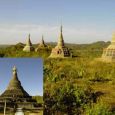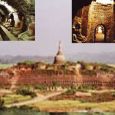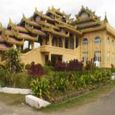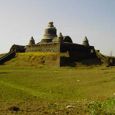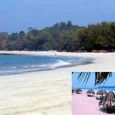Rakhing
Advertisement
There are daily fights from Yangon to Sittwe and daily flights from Yangon, Heho and Bagan to Thandwe (Ngapali Beach). Private express coaches are running from Yangon via Pyay to Thandwe, but the road from Pyay to Thandwe is not good and it takes at least 16 hours to get there.
.
Rakhaing State Cultural Museum
The Myanmar government run Myanmar Rakhaing State Cultural Myanmar Museum (Main Rd. admission US$2; 10am-4pm, Tue-Sat) is worth a look for its two floors of Rakhaing People's cultural goodies. On the ground floor, diagram, artifacts and signs in English detail how the Myanmar Rakhaing Culture started their civilization here around 3000BC and about Buddha's purported visit in 554 BC. There's an imaginative rendering of Mrauk U in full steam that looks more Jules Verne, with housed archways connecting hilltops.
Upstairs are displays on Myanmar local customs (eg models showing off some of the 64 Mrauk U royal hairstyles), festivals (including the ra hta pwe, a three day tug of war) and water color drawings detailing key moves you may need if you ever undergo a game of traditional Myanmar Rakhaing wrestling.
Buddhist Museums
A life's work by Sittway Myanmar monk Bhaddanta Wannita, who spent 49 years collecting old coins and Buddha images from Myanmar monasteries to protect them from thieves, has resulted (seemingly) in a little tug of war between his former Myanmar monastery and a Myanmar government opened museum.
His former monastery, the Maha Kuthala Kyaungdawgy (large Monastery of Great Ment; Main Rd; admission free), is housed in (of all things) a grand, century old British colonial mansion north of the centre. The modest Myanmar museum upstairs contains cases of of "Union of Burma" notes, Buddhas and votives and coins from the Mrauk U and other ancient periods, plus a full case of more recent golf trophies.
A less satisfying collection, borrowed from some of Wannitas collection apparently, is at the Buddhistic Myanmar Museum (Baw Dhi St; admission free), an official looking building made by Myanmar government in 1992. Inside are dozens of small ancient Buddha images and votive tablets.
The big pagoda between the museum and the centre is the Lokananda Paya, put up by Myanmar General Than Shwe himself in 1997.On Saturday, soldiers shuffle to scrub clean the giant walkway around it. Just north is a small ordination hall, which houses the Sachamuni image, a 1.5m bronze Buddhas. Apparently the image was found by Mrauk U Myanmar fishers in in recent years previously thrown in the river to escape British destruction. One Myanmar local said. It was housed at the Bandoola Monastery in Mrauk U until Myanmar government moved it here in 1997. It's (unrealistically) claimed to date from 24BC.
Andaw Paya Mrauk U
Immediately northeast of Shittaung stands a smaller, eight-sided monument with a similar linear, eight-sided monument with a similar linear layout: rectangular prayer hall to the east, multispired sanctuary to the west. Sixteen zedi (stupas) are aligned in a square-cornered U shape around the southern, nouthern and western platforms. As at Shittaung, small windows admit light and ventilation, but here fluorescent glare is dimmer. Two concentric passageways are lined with Buddha niches; in the centre of the shrine, an eight-sided piller supports the roof.
The original construction of the shrine is ascribed to King Minhlaraza in 1521. king Minarazayi then rebuilt Andaw in 1596 to enshrine a piece of the tooth relic supposedly brought from Sri Lanka by king Minbin in the early 16th century, Most likely the roofline sikhara date to his later reconstruction, as their slender, terraced style is very different from that found at Shittaung.
Daukkanthein Paya Mrauk U
Across the road to the northwest of Shittaung, the Dukkanthein (the name loosely means "ordination hall that spiritually reinforces the town") smacks of a bunker (with stupas) set impressively on its small bluff amid a green field. Wide stone steps lead up the south and east side; take the latter to reach the entrance.
Built by king Minphalaung in 1571 in particularly troubled times, Daukkanthein's interior features spiraling cloisters lined with images of Buddha and, as per astrologers' strategic advice to the king, of common people, landlords, governors, officials and (notably) their spouses, who famously show off all of Mrauk U's 64 traditional hairstyles. Along the way, stairs lead off to an ordination hall. The passageway nearly encircles the centre three times before reaching the sun-drenched Buddha image set above the inner stairway. A fine paya pwe is held near the paya in mid-May.
The laymyetnha paya, 100m north, looks a bit like a squashed-up version of the Dukkanthein, but was actually built 140 years earlier. Inside the unrenovated padoda, a round passage lined with Buddha images.
Roughly 1km northeast of the Palace walls, and behind Shwegudaung hill, this graceful zedi was erected in 1629 by King Thirithudhammaraza. At this later stage, stupas were built more vertically and ornate than before absorption of Burma and Shan styles).
The lower half of the well-preserved 85m zedi features a multitiered octagonal shape as at laungbanpyauk Paya, but beyond this the bells reverts to a layered circular shape mounted by a decorative hti (umbrellalike top). At the western gate are a couple of half-kneeling, painted giants.
Ngapali Beach Myanmar
Myanmar's most popular beach destination features a 3km plam-backed stretch of (for the time being) pretty quiet, pretty empty white-sand Myanmar public beach. Named, some say, by a wayward Italian thinking of his Naples home, Ngapli has about 10 Myanmar bungalow hotels, with Myanmar traditional fishing villages in the area.Myanmar local life still shares the sand with (mostly European) foreign guests, as occasional ox carts meander by sunbathers in Myanmar Ngapali beach.
Historically isolated the Myanmar bus trip here still remains the monster trip of Myanmar's most popular desolations the nearby Thandwe Myanmar airport has triggered a more midrange crowd streaming in. At research time, five new Myanmar hotel projects (some joint ventures) were under way (these are listed on the map), and one-time cheapie Myanmar guest houses have scrubbed their rooms clean and upped their prices.
No topless or nude bathing is allowed Surfing is possible during monsoon season (mid-May through to mid-September) when malaria precautions should be taken. Most Myanmar hotels stay open all year, but it's quiet from April to October in Myanmar.
Sittway Myanmar
Propped impressively where the wide tidal Kaladan River mouth kisses the Bay of Bengal, Sittway Myanmar may sound like a quaint spot for water-watching strolls. For most visitors, it's just a hurry and leave transfer point for visitors heading to Mrauk U the Myanmar ancient Rakhine State Capital. The fish market, friendly folk and spicy dishes can easily fill the half a day you need on either side of Mrauk U trip. The population is about 30% Muslim.
A port town of note for a couple of hundred years and inhabited for a couple of thousand, Sittwe boomed when the British moved the Rakhaing capital here from Mrauk U in the early 19th century in Myanmar. Incoming wealth from cargo trade with Calcutta fuelled the construction of some fine Myanmar colonial mansions, but much of the grace was lost under heavy WWII raids
Information not available


